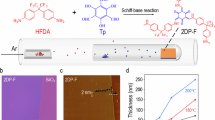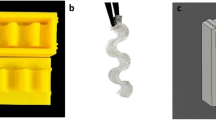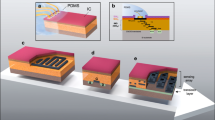Abstract
The demand for monolithic structures in many applications has increased to enable more reliable and optimized performances such as for dielectric electroactive polymers (DEAPs). For the layers of the elements to grow efficiently together, it is first of all required that the layers adhere together to enable interlayer crosslinking reactions either by application of an adhesion promoter or by ensuring that there are reactive, complementary sites available on the two surfaces. Polydimethylsiloxane (PDMS) is a widely used polymer for DEAPs. In this work, two-layered PDMS films are adhered together at different curing times. The monolithic films are investigated by rheology, scanning electron microscope, mechanical testing, dielectric relaxation spectroscopy, thermal gravimetric analysis (TGA) and differential scanning calorimetry (DSC). The morphology, mechanical and dielectric properties, as well as thermal stabilities of the bilayer elastomer films are observed to change with the curing time of the monolayers before lamination. The objective of this work is to create adhesion of two layers without destroying the original viscoelastic properties of the PDMS films, and hence enable, for example, adhesion of two microstructured films which is currently a crucial step in the large-scale production of DEAPs.
Similar content being viewed by others
Log in or create a free account to read this content
Gain free access to this article, as well as selected content from this journal and more on nature.com
or
References
Benslimane, M., Tryson, M. J., Oubak, J. & Kiil, H. E. in Electroactive Polymer Actuators and Devices (EAPAD): 7976 79760I-1 79760I-13. Proc. of SPIE (eds Yoseph B. C. & Federico C.) (San Diego, CA, USA, 2011).
Benslimane, M., Kiil, H. E. & Tryson, M. J. in Electroactive Polymer Actuators and Devices (EAPAD): 7642 764231-1 764231-11, Proc. of SPIE (ed. Yoseph, B. C.), (San Diego, CA, USA, 2010).
Unger, M. A., Chou, H. P., Thorsen, T., Scherer, A. & Quake, S. R. Monolithic microfabricated valves and pumps by multilayer soft lithography. Science 288, 113–116 (2000).
Sansiñena, J. M., Gao, J. & Wang, H. L. High-performance, monolithic polyaniline electrochemical actuators. Adv. Funct. Mater. 13, 703–709 (2003).
Xu, L. R., Sengupta, S. & Kuai, H. C. An experimental and numerical investigation of adhesive bonding strengths of polymer materials. Int. J. Adhes. Adhes. 24, 455–460 (2004).
Poisson, C., Hervais, V., Lacrampe, M. F. & Krawczak, P. Optimization of PE/binder/PA extrusion blow-molded films. II. Adhesion properties improvement using binder/EVA blends. J. Appl. Polym. Sci. 101, 118–127 (2006).
Öchsner, A., Stasiek, M., Mishuris, G. & Grácio., J. A new evaluation procedure for the butt-joint test of adhesive technology: determination of the complete set of linear elastic constants. Int. J. Adhes. Adhes. 27, 703–711 (2007).
Comyn, J. in Handbook of Adhesives and Sealants 2 (ed. Cognard P.) (Elsevier, Amsterdam, Netherlands, 2006).
Haghani, R., Emrani, M. A. & Kliger, R. Stress distribution in adhesive joints with tapered laminates-effect of tapering length and material properties. J. Compos. Mater 44, 287–302 (2010).
Kumar, P., Singh, R. K. & Kumar, R. Joining similar and dissimilar materials with GFRP. Int. J. Adhes. Adhes. 27, 68–76 (2007).
Kadioglu, F. & Souni, M. E. Use of thin adherends in adhesively bonded joints under different loading modes. Sci. Technol. Weld. Joining 8, 437–442 (2003).
Okuzu, T. & Kuwata, H. Easy adhesion polyamide film and production method, therefor. US 2012/0003440 A1, 2012-01-05.
Watson, C. in Handbook of Adhesion 138 (ed. Packham D. E.) (Wiley, Hoboken, NJ, USA, 2005).
Packham, D. E. Adhesive technology and sustainability. Int. J. Adhes. Adhes. 29, 248–252 (2009).
Loher, S. & Stark, W. J. Rapid production of micropatterned surfaces using a fluid dynamical instability. Polym. Eng. Sci. 46, 1541–1547 (2006).
Kulmi, U. & Basu, S. A molecular dynamics study of the failure modes of a glassy polymer confined between rigid walls. Modell. Simul. Mater. Sci. Eng 34, 948–968 (2009).
Awaja, F., Gilbert, M., Kelly, G., Fox, B. & Pigram, P. J. Adhesion of polymers. Prog. Polym. Sci. 34, 948–968 (2009).
Kinloch., A. J. The science of adhesion. I. Surface and interfacial aspects. J. Mater. Sci. 15, 2141–2166 (1980).
Adnan, A. & Sun, C. T. Effect of adhesive thickness on joint strength: a molecular dynamics perspective. J. Adhes. 84, 401–420 (2008).
Skov, A. L., Bejenariu, A. G., Bøgelund, J., Benslimane, M. & Egede, A. D. in Electroactive Polymer Actuators and Devices (EAPAD): 8340 83400M-1 83400M-10. Proc. of SPIE (ed. Yoseph B. C.) (San Diego, CA, USA, 2012).
Jensen, M. K., Bach, A., Hassager, O. & Skov, A. L. Linear rheology of cross-linked polypropylene oxide as a pressure sensitive adhesive. Int. J. Adhes. Adhes. 29, 687–693 (2009).
Bejenariu, A. G., Rasmussen, H. K., Skov, A. L., Hassager, O. & Frankaer, S. M. Large amplitude oscillatory extension of soft polymeric networks. Rheol. Acta 49, 807–814 (2010).
Bejenariu, A. G., Yu, L. Y. & Skov, A. L. Low moduli elastomers with low viscous dissipation. Soft Matter 8, 3917–3923 (2012).
Winter, H. H. & Chambon, F. Analysis of linear viscoelasticity of a cross-linking polymer at the gel point. J. Rheol 30, 367–382 (1986).
Lin, P. C., Vajpayee, S., Jagota, A., Huid, C. Y. & Yang, S. Mechanically tunable dry adhesive from wrinkled elastomers. Soft Matter 4, 1830–1835 (2008).
Wolff, F., Kugler, C. & Münstedt, H. Time- and temperature-dependent crosslinking behavior of a silicone resin. Rheol. Acta 51, 71–80 (2012).
Ramesh, K., Tock, R. W., Narayan, R. S. & Vallabhan, C. V. G. Property evaluation of silicone elastomers used in tension-adhesion joints. J. Mater. Sci. Lett. 14, 964–967 (1995).
Torres, J. M., Wang, C. Q., Coughlin, E. B., Bishop, J. P., Register, R. A., Riggleman, R. A., Stafford, C. M. & Vogt, B. D. Influence of chain stiffness on thermal and mechanical properties of polymer thin films. Macromolecules 44, 9040–9045 (2011).
Fedorchenko, A. I., Wang, A. B. & Cheng, H. H. Thickness dependence of nanofilm elastic modulus. Appl. Phys. Lett. 94, 152111-1–152111-3 (2009).
Diaconu, I., Dorohoi, D. O. & Ciobanu, C. Electromechanical response of polyurethane films with different thickness. Rom. J. Phys 53, 91–97 (2008).
Cho, S. M., Hong, J. H., Kim, Y. T. & Lee., S. D. Adhesive-transfer bonding technique for flexible liquid crystal displays with high mechanical stability. Mol. Cryst. Liq. Cryst 513, 1–8 (2009).
Aarash, Y. N. S. & Cristina., M. A vapor-assisted method for adhering polydimethylsiloxane and glass. Lab. Chip. 10, 250–253 (2010).
Delebecq, E., Hermeline, N., Flers, A. & Ganachaud, F. Looking over liquid silicone rubbers: (2) Mechanical properties vs network topology. ACS Appl. Mater. Interfaces 4, 3353–3363 (2012).
Sahoo, B. P., Naskar, K. & Tripathy, D. K. Conductive carbon black-filled ethylene acrylic elastomer vulcanizates: physico-mechanical, thermal, and electrical properties. J. Mater. Sci. 47, 2421–2433 (2012).
Yu, L. Y., Xu, Z. L., Shen, H. M. & Yang, H. Preparation and characterization of PVDF-SiO2 composite hollow fiber UF membrane by sol-gel method. J. Membr. Sci. 337, 257–265 (2009).
Patwardhan, S. V., Taori, V. P., Hassan, M., Agashe, N. R., Franklin, J. E., Beaucage, G., Mark, J. E. & Clarson., S. J. An investigation of the properties of poly(dimethylsiloxane)-bioinspired silica hybrids. Eur. Polym. J. 42, 167–178 (2006).
Kuo., A. C. M. in Polymer Data Handbook 2nd edn (ed. Mark J. E.) 547 (Oxford University Press, Oxford, UK, 2009).
Rochery, M., Vroman, I. & Lam, T. M. Incorporation of poly(dimethylsiloxane) into poly(tetramethylene oxide) based polyurethanes: the effect of synthesis conditions on polymer properties. J. Macromol. Sci. Pure Appl. Chem. 40, 321–333 (2003).
Acknowledgements
We gratefully acknowledge the financial support from the Danish National Advanced Technology Foundation. Michael Daniel Junker, Danfoss PolyPower, is acknowledged for his help with the mechanical tests.
Author information
Authors and Affiliations
Corresponding author
Rights and permissions
About this article
Cite this article
Yu, L., Skov, A. Monolithic growth of partly cured polydimethylsiloxane thin film layers. Polym J 46, 123–129 (2014). https://doi.org/10.1038/pj.2013.72
Received:
Revised:
Accepted:
Published:
Issue date:
DOI: https://doi.org/10.1038/pj.2013.72



